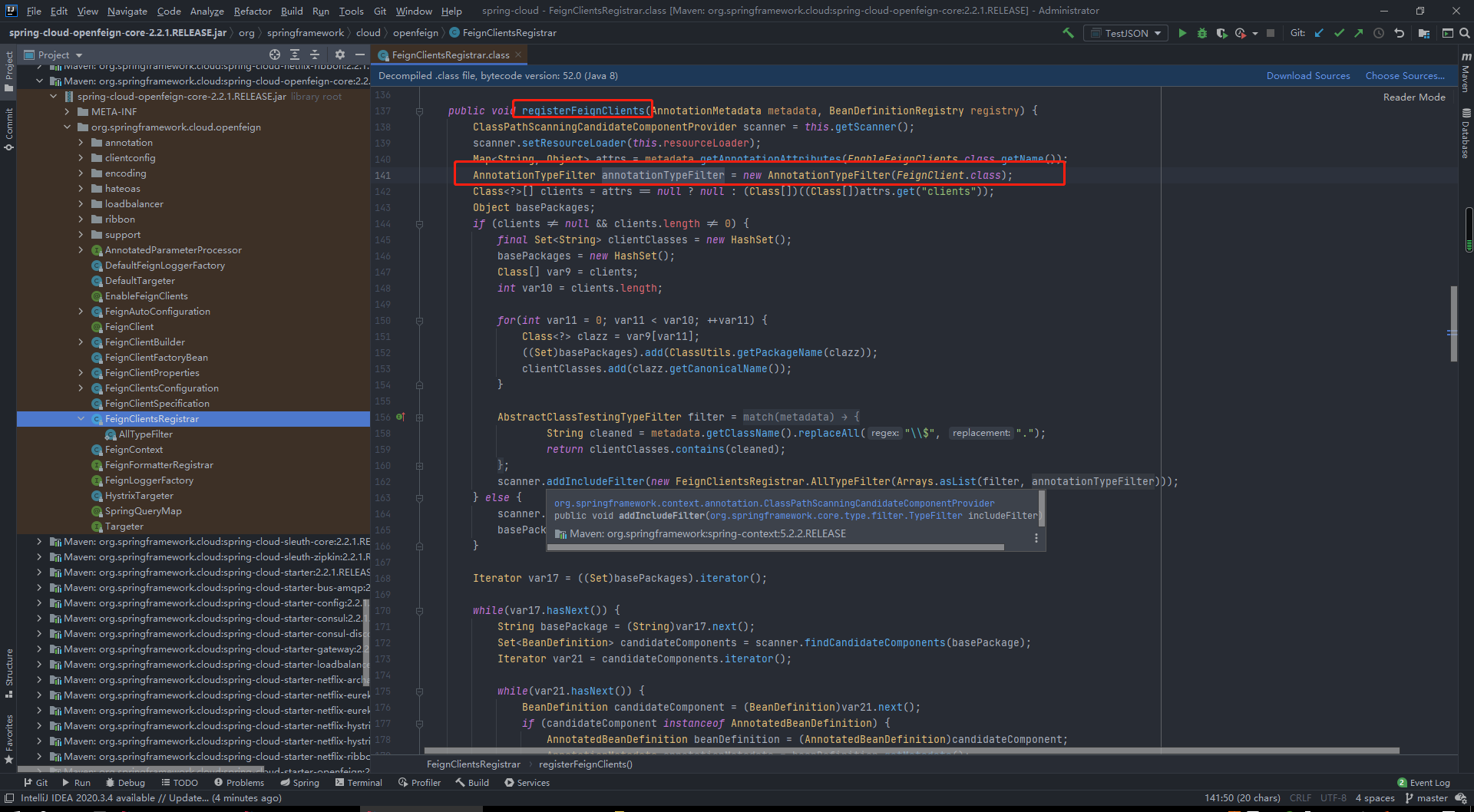1, Meta annotation
1. @ target (action target)
Scope of annotation
| type | explain |
|---|---|
| ElementType.TYPE | Class, interface (including annotation type) or enum declaration |
| ElementType.FIELD | Fields, enumerating constants |
| ElementType.METHOD | Method declaration |
| ElementType.PARAMETER | Parameter declaration |
| ElementType.CONSTRUCTOR | Constructor declaration |
| ElementType.LOCAL_VARIABLE | Local variable declaration |
| ElementType.PACKAGE | Package declaration |
| ElementType.LOCAL_VARIABLE | local variable |
| ElementType.ANNOTATION_TYPE | annotation |
2. @ retention (retention policy)
Indicates the level at which the annotation information is saved
| type | explain |
|---|---|
| RetentionPolicy.SOURCE | Annotations exist only in the source code and are not included in the class bytecode file |
| RetentionPolicy.CLASS | With the default retention policy, annotations exist in the class bytecode file, but cannot be obtained at run time |
| RetentionPolicy.RUNTIME | Annotations exist in the CLASS bytecode file and can be obtained by reflection at RUNTIME. First, specify the life cycle length SOURCE < CLASS < RUNTIME, so where the former can work, the latter must also work. Generally, if you need to dynamically obtain annotation information at RUNTIME, you can only use RUNTIME annotation; If you want to perform some preprocessing operations during compilation, such as generating some auxiliary code (such as ButterKnife), use CLASS annotation; If you only do some checking operations, such as @ Override and @ SuppressWarnings, you can use the SOURCE annotation. |
3,@Documented
Include this annotation in javadoc, which means that this annotation will be extracted into documents by javadoc tools. The content in the doc document will vary according to the information content of this annotation. Equivalent to @ see,@param, etc.
4,@Inherited
Inherited means inheritance, but it does not mean that it can be inherited directly, but that a superclass is annotated by @ Inheritedh,
2, Reflection
The reason why reflection is explained here is that annotation and reflection are closely related. Without reflection, the annotation function cannot be parsed.
1. Concept
class Method Field Constructor
2. Reflection core class
java.lang.Class; class java.lang.reflect.Constructor; Constructor method java.lang.reflect.Field; attribute java.lang.reflect.Method; method java.lang.reflect.Modifier; Modifier
3. Class loading has three stages
1,source code(source)
The original code does not refer to java File, yes class Bytecode file
2,Class loading(class)
class Bytecode file via classloader classloader Load into the virtual machine memory, and the class loader resolves class File generation Class Object of type
3,Runtime(runtime)
newInstance()according to java Type generation object
4. Three methods to get class objects
1,Class class=Class.forName("com.xx.xx.xx.Person");
2,Class<Person> class=Person.class;
3,Person p=new Person();
Class class=p.getClass();
3, Parsing annotation (source code analysis)
Write an annotation, customize and return your own toString method. Return the format you want
The complete code can be viewed under this project cloud-annotation
1. Create custom annotation
| Annotation name | function |
|---|---|
| @JsonFormat | Formatting function |
| @JsonIgnore | Ignore function |
| @JsonProperty | Attribute name |
/**
* Acts on the attribute, and the user formats the date as required
*/
@Target(ElementType.FIELD)
@Retention(RetentionPolicy.RUNTIME)
@Inherited
public @interface JsonFormat {
String pattern() default "yyyy-MM-dd HH:mm:ss";
}
/**
* Acts on attributes to ignore some attributes
*/
@Target(ElementType.FIELD)
@Retention(RetentionPolicy.RUNTIME)
@Inherited
public @interface JsonIgnore {
}
/**
* property alias
*/
@Target(ElementType.FIELD)
@Retention(RetentionPolicy.RUNTIME)
@Inherited
public @interface JsonProperty {
String value(); //Value must be given when using
2. After the annotation is defined, customize the tojsonstring (similar to toString) method
package com.xwb.springcloud.annotation.json;
import java.lang.reflect.Field;
import java.text.SimpleDateFormat;
import java.util.Date;
@SuppressWarnings("all")
public class JSON {
public static String toJSONString(Object object) {
StringBuffer json = new StringBuffer();
try {
//1. Get the Class object of object
Class<?> clazz = object.getClass();
//2. Get all the attributes in class
Field[] fields = clazz.getDeclaredFields();
//3. Loop through all attributes to break the access rights of attributes
int index = 0;
//Get attribute length
int length = fields.length;
json.append("{");
for (Field field : fields) {
index++;
//Judge whether there are ignored annotations on the attribute
if (field.isAnnotationPresent(JsonIgnore.class)) {
continue;
}
//Private variable readability
field.setAccessible(true);
//4 get the attribute name as the key of json
String name = field.getName();
//5. Get the attribute value as the json value
Object value = field.get(object);
//Judge whether there is a comment to change the name on the attribute
if (field.isAnnotationPresent(JsonProperty.class)) {
//If so, take out the name on the annotation
JsonProperty annotation = field.getAnnotation(JsonProperty.class);
name = annotation.value();
}
json.append("\"" + name + "\"");
if (value instanceof String) {
json.append(":\"" + value.toString() + "\"");
} else if (value instanceof Date) {
//If it is a date here, judge whether there is a comment formatted from the date
Date date = (Date) value;
if (field.isAnnotationPresent(JsonFormat.class)) {
JsonFormat format = field.getAnnotation(JsonFormat.class);
json.append(":\"" + parseDateToStr(date, format.pattern()) + "\"");
} else {
json.append(":\"" + date.getTime() + "\"");
}
} else {
json.append(":" + value.toString());
}
if (index != length) {
json.append(",");
}
}
json.append("}");
return json.toString();
} catch (Exception e) {
System.out.println(e.getCause());
}
return null;
}
public static String parseDateToStr(Date date, String format) {
SimpleDateFormat sdf = new SimpleDateFormat(format);
return sdf.format(date);
}
}
explain:
The defined annotation has no effect, but if you want the annotation to play its role, you need to define corresponding methods to parse it, and then let it play its role.
Who defines the annotation, who parses it. Instead of saying that the annotations defined by him let java parse them, he doesn't recognize them.
3. Call
public class TestJSON {
public static void main(String[] args) {
User user = new User(1, "Zhang San", "Yinchuan, Ningxia", new Date());
String s = JSON.toJSONString(user);
System.out.println(s);
}
}
4. Output results
{"user_name": "Zhang San", "user_address": "Yinchuan, Ningxia", "birth": "2021-11-12"}
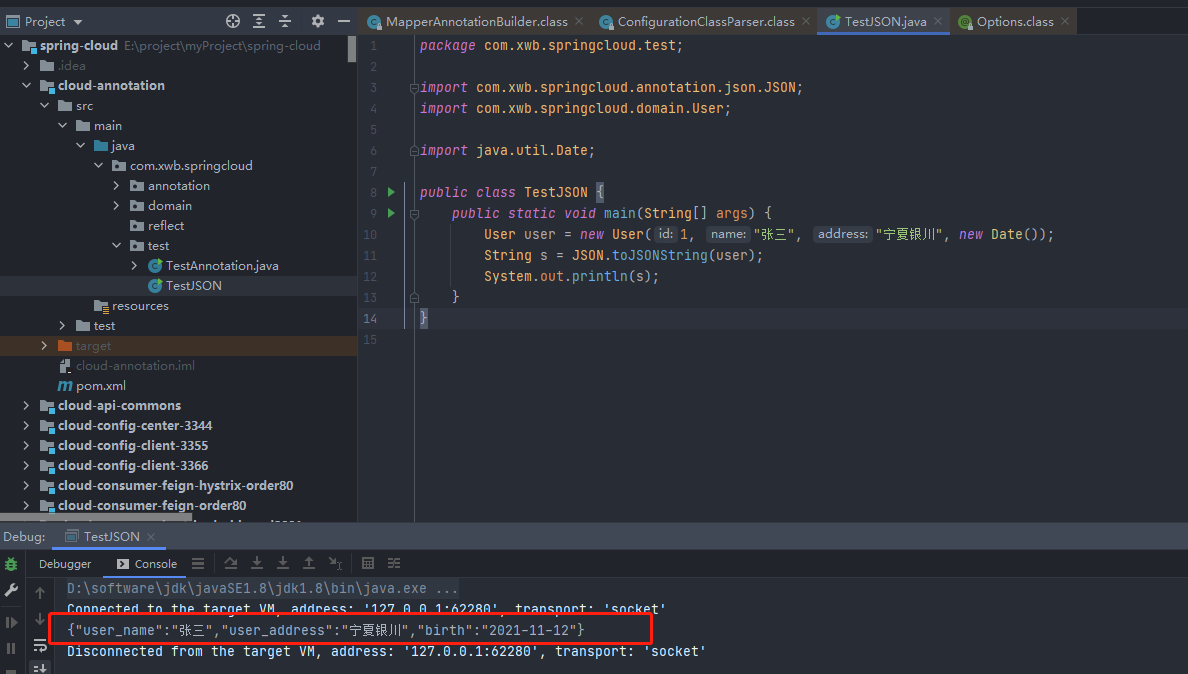
Example
Summary: the annotation itself has no function, it is just a statement. The specific function is to define what function the annotation developer wants it to play, and then use reflection in the corresponding parsing method to obtain whether there is the annotation on classes, attributes, methods, parameters... And if so (xxx instanceof xxx) to implement the function method according to the developer's own ideas.
The shortcut key used to find the class or method in the source code is [ctrl+n]
1. spring @ RequestBody annotation
Resolve the RequestResponseBodyMethodProcessor class under the package spring-webmvc-5.2.2.RELEASE.jar
For a detailed description of this annotation, please watch this blog @RequestBody
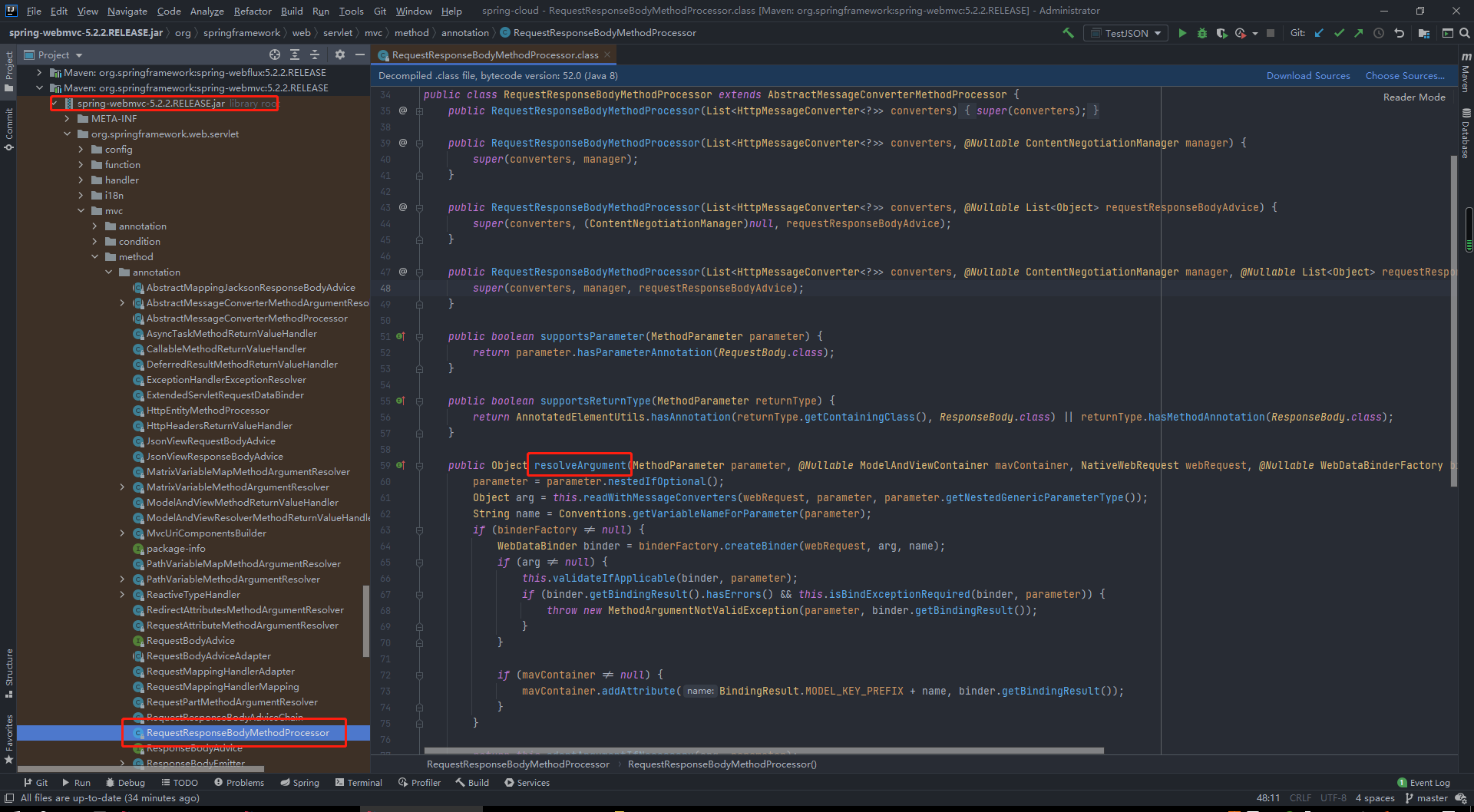
2. mybatis @ Mapper annotation
MapperAnnotationBuilder class parse method RequestResponseBodyMethodProcessor under mybatis-3.4.4.jar package
See this blog for @ Mapper @Mapper
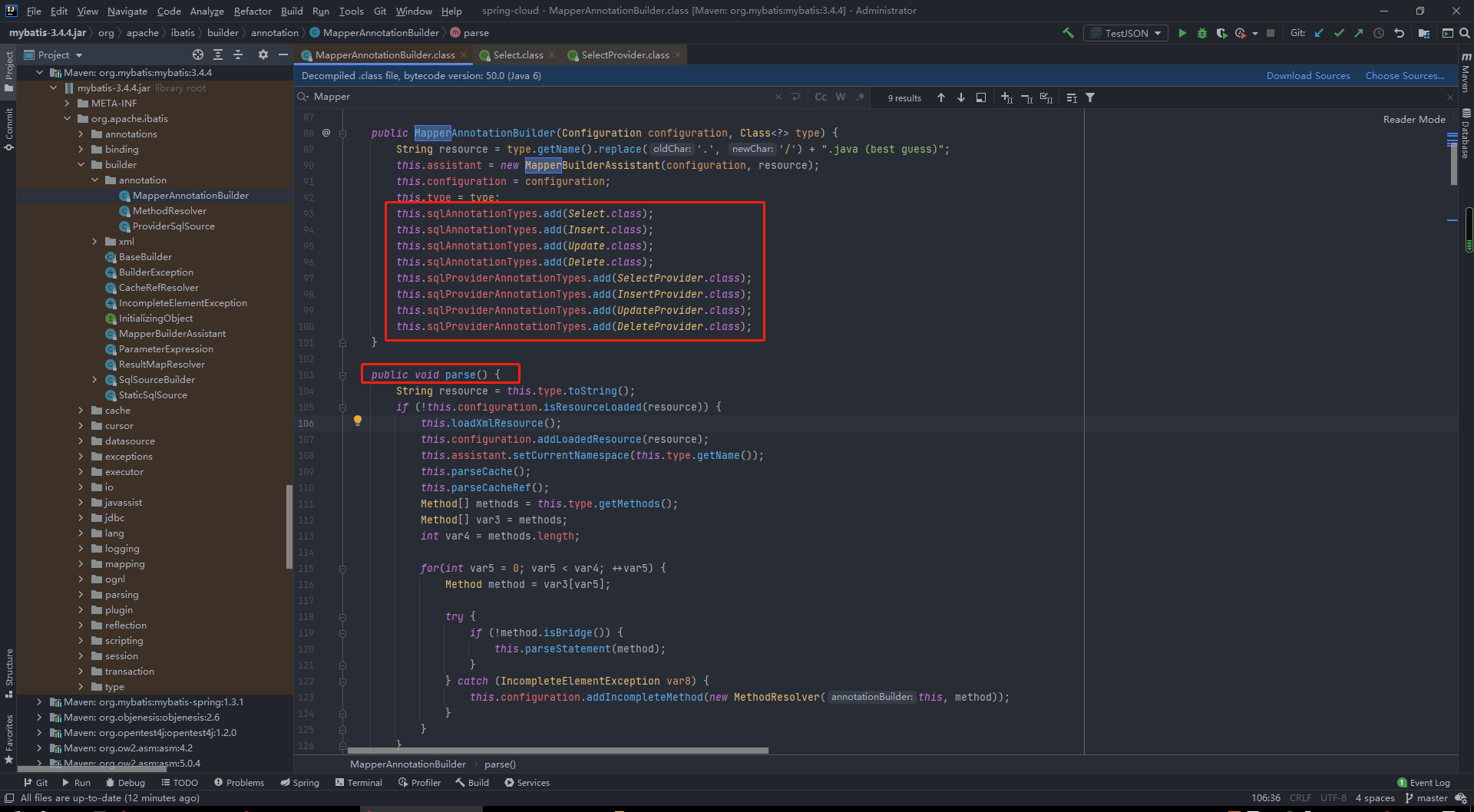
3. spring @ Configuration
ConfigurationClassPostProcessor class under spring-context-5.2.2.RELEASE.jar package
For detailed explanation of the source code, you can view the blogger's blog @Configuration
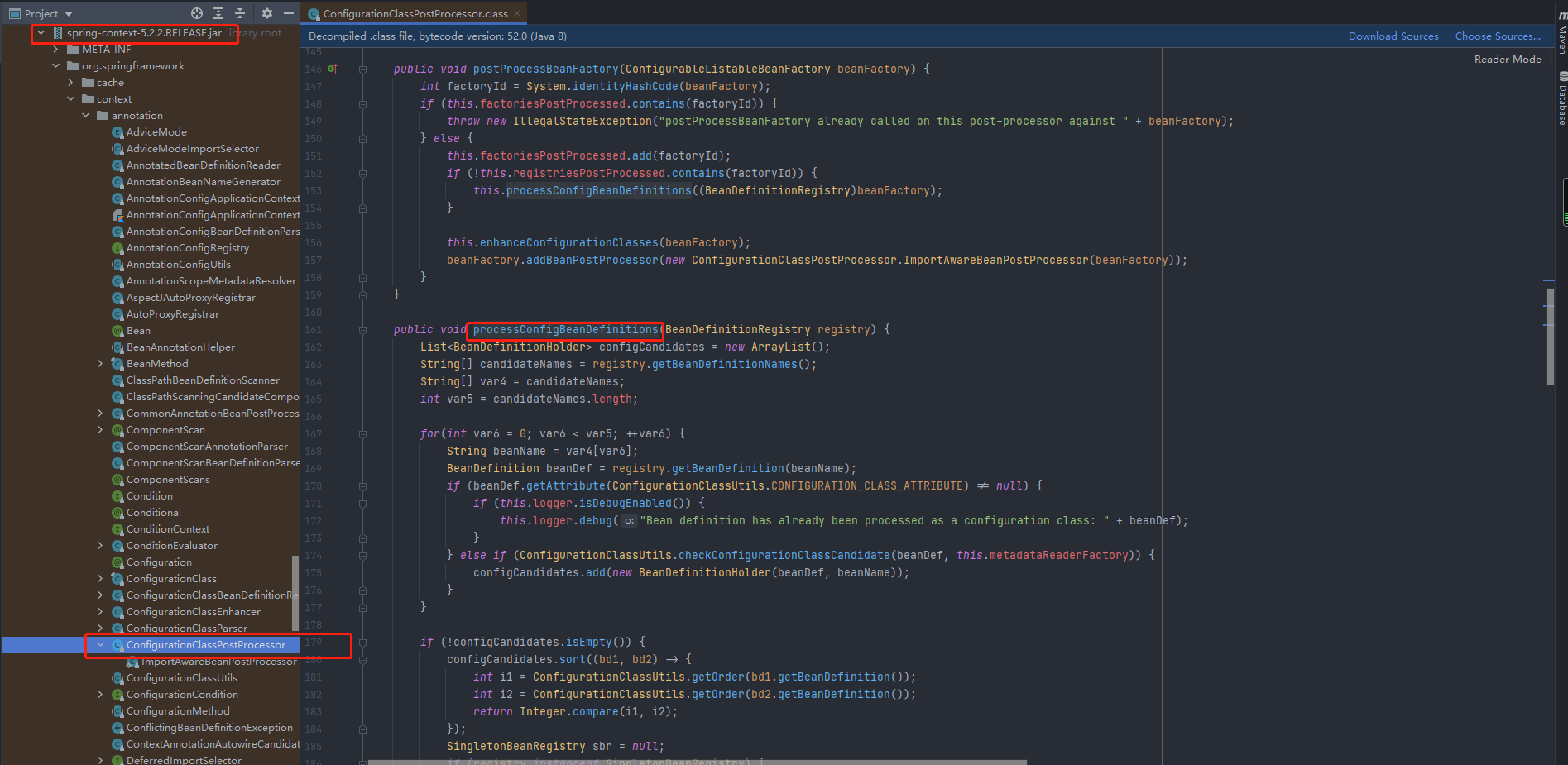
4. @ FeignClient annotation for springcloud
Feignclientsregister class of spring-cloud-openfeign-core-2.2.1.RELEASE.jar package
For the source code analysis of @ FeignClient, please see this blog @FeignClient
